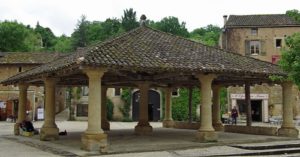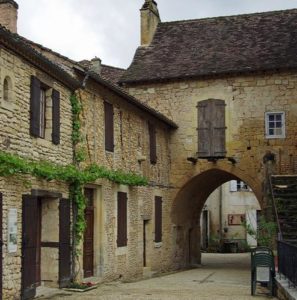Cadouin is another small village in the Dordogne Region, with a few shops and a big stone market hall dominated by its abbey. This is rather an austere building of pale yellow stone which has become blacked in places.
In the Middle Ages, Cadouin was an important place of pilgrimage as it was thought to have part of the Holy Shroud believed to have been wrapped around Christ’s head. This was suspended in a casket above the altar. In the 1930s it was examined and found to be 11thC as it had embroidered bands of Kufic script about an emir and Caliph who ruled in Egypt in the 11thC. It was removed form the Abbey and pilgrimages discontinued. It is now on display in the Chapter House. It is still possible to see the chains above the altar which held the casket.
At the east end is an unusual small bell tower with a double pointed roof. The abbey has a massive buttressed west front which masks the roof line. A central doorway is set under round arches with PAX carved at the top. On the left are two blind arches with pillars and round arches. Above, set between the buttresses are three large round topped windows. Above is another arcade of blind arches with a small round window in the centre. To the right of the abbey is a large stone building which would have been part of the Abbey buildings but is now the Marie.
Facing the abbey is an attractive row of small stone house with shutters lining an open square. Beyond them is an old gateway across the street.Beyond the gateway are large old houses with pigeon lofts. There are a few shops around the square including a bakers, Tabac and cafe, épicerie and a shop selling local produce with a very large black Newfoundland dog called Ebony asleep outside.
Inside, it is a huge and plain Romanesque building with large pillars with round arches separating nave and side aisles and a barrel ceiling with ribs. There is a narrow carved frieze round the top of the walls of the side aisles. A locked doorway on the south wall would have lead into the cloisters. We peeped through for a glimpse.
At the back of the nave is a pieta with Joan of Arc on the north side and a crucifix on the south side.
There is an altar under the transept with an altar rail round it. The transept pillars have beautifully carved capitals and statues include the Virgin Mary and Christ Child as well as St Joseph and the boy Jesus. The south transept has a decorative shield on the wall.
The chancel has a small stone altar and is pure Roman round wall pillars with ‘water flower’ carved capitals and round arches around the walls. Between them are round topped windows with modern stained glass. On either side are small apses. The south has a small painted statue of St Géraud de Salle; the left a painted statue of the Virgin and Child. There is the remains of a fresco of a knight with a lion. Round the walls is a black funerary band with badges.
The chancel has a blue painted ceiling with yellow fleur de lys and two angels holding a banner inscribed with IHS sanctum sudarium”. The ceiling rib has a grey and blue scroll pattern on a plum background. Behind is a mural of Christ stepping out of the sepulchre holding a metal cross and banner with a red flag, while the Roman soldiers are sleeping. The buildings of Jerusalem can be seen behind Christ.
Cadouin is a popular stop on the tourist route and for coach parties. Most people head for the cloisters. These are accessed through the Tourist Office and cost €6. They were built in the 15thC and heavily restored in the 19thC when the capitals were restored. The brief glimpse we got of them through the locked door in the Abbey didn’t encourage us to visit.
The abbey was interesting but not a must see. We preferred St-Avit-Senieur a few miles to the south west. Like Cadouin it also receives 1* on the Michelin motoring atlas but is ignored by the tourists.









